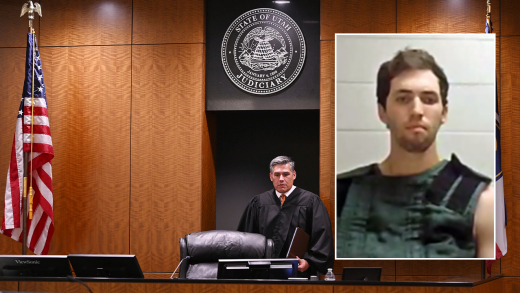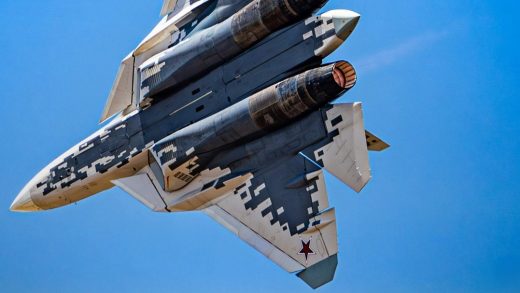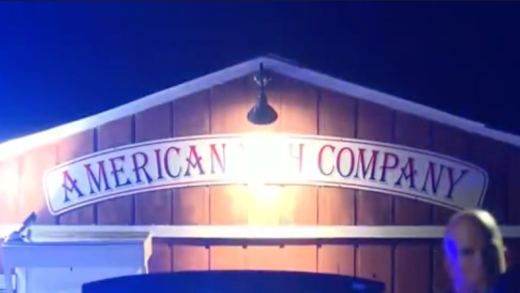
Gaitero groups, dancers and the general public parade to the cemetery in San Jacinto, Colombia, on Aug. 14, 2022.
Karla Gachet
hide caption
toggle caption
Karla Gachet
This is part of a special series, Cumbia Across Latin America, a visual report across six countries covering the people, places and cultures that keep this music genre alive.
All dance was seen as rebellious during colonial times. The Caribbean coast of Colombia witnessed the birth of cumbia in the river system of the Mompos Depression, an immense wetland, and in a small mountain range known as Montes de María. During the colonization of America in the 16th century, thousands of enslaved individuals arrived from the African continent at the port of Cartagena. Forced to leave their homeland, they brought their music, religious drums and spirituality. These drums were also used to send secret messages during the maroonage process.

Diomar Trigos (from left to right), Esneider Páez, Humberto Cañizares and Sebastián Suárez stand in the street after participating in the Pocabuyano Parade in El Banco, Magdalena, Colombia, during the National Festival of Cumbia, on Oct. 15, 2022. They are representing the town of San Alberto, Cesar, and are wearing traditional cumbia clothing.
Ivan Kashinsky
hide caption
toggle caption
Ivan Kashinsky
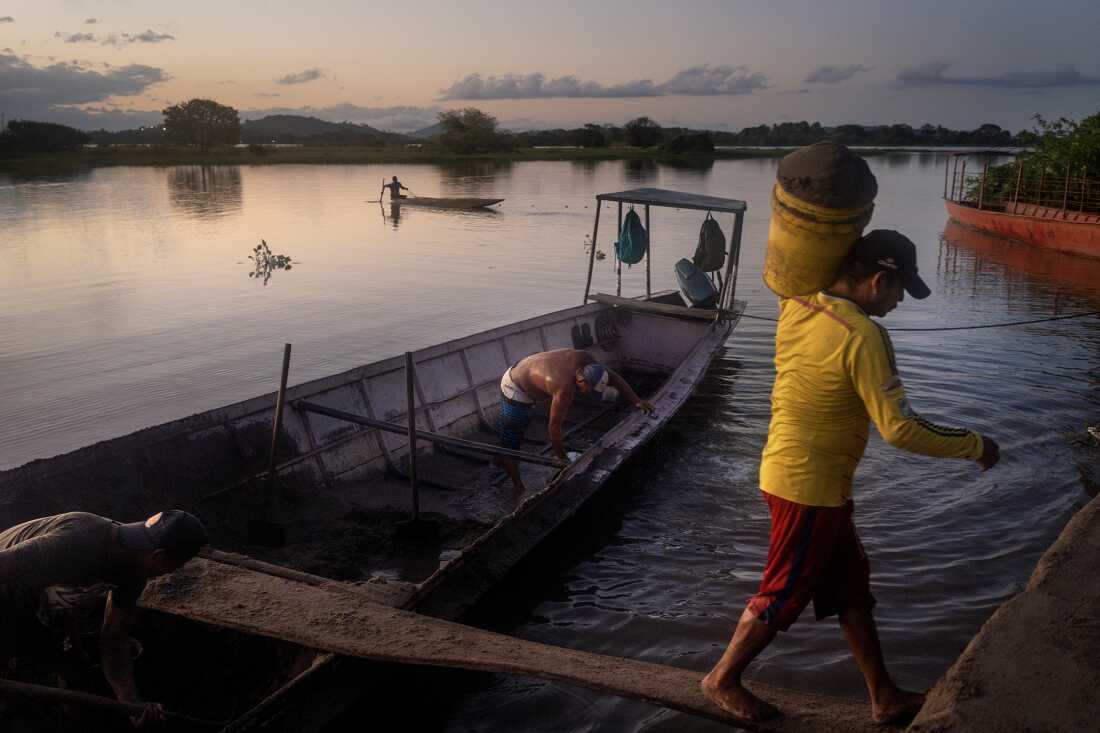
Workers unload sand collected farther down the river and brought to El Cesar’s dock near El Banco, Magdalena, Colombia, on Aug. 8, 2022.
Karla Gachet
hide caption
toggle caption
Karla Gachet
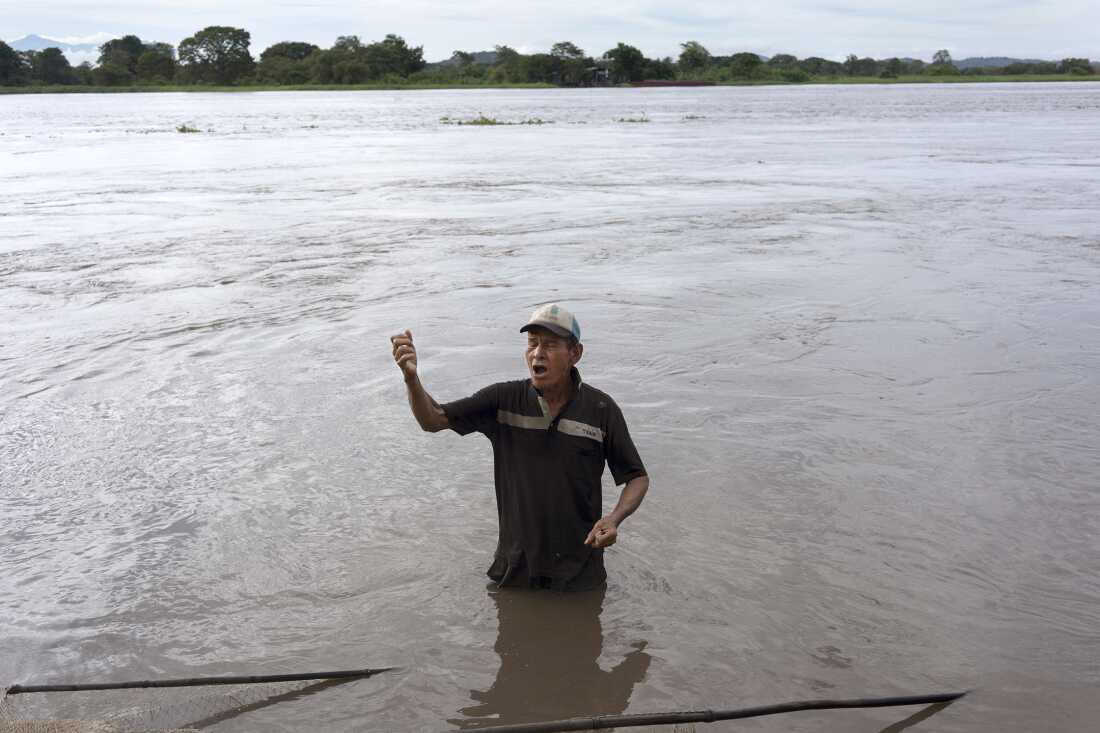
José Benito Africano Mendoza sings cumbias to people hanging out along the Magdalena River in El Banco, Magdalena, Colombia, on Aug. 7, 2022.
Ivan Kashinsky
hide caption
toggle caption
Ivan Kashinsky
The swamp region was home to many Indigenous cultures, now referred to as amphibious due to their proximity to water. These cultures are said to have used flutes made from bone in ceremonial rites. In the Montes de María, where additional Indigenous groups lived, small statuettes of human figures with instruments resembling gaitas (Indigenous flutes) — also known as chuanas — have been found. The clothing used in traditional dance, trova, and couple dancing, and the language of the songs exemplify European influence. The musical instruments of this region are crafted from the earth, mimicking birds that fly along the banks of rivers, the sound of rain or the beating of a heart.

Carlos Casas Serrano makes a tambor alegre, a traditional drum used in cumbia, in the workshop of Colilo Lara on Aug. 12, 2022, in San Jacinto, Bolivar, Colombia, during the Festival Nacional Auntóctono de Gaitas.
Ivan Kashinksy
hide caption
toggle caption
Ivan Kashinksy

A portrait of Orlando Jose Blanco Alvarez and his tambor alegre on Aug. 12, 2022, during the Festival Nacional Autóctono de Gaitas in San Jacinto, Colombia.
Karla Gachet
hide caption
toggle caption
Karla Gachet
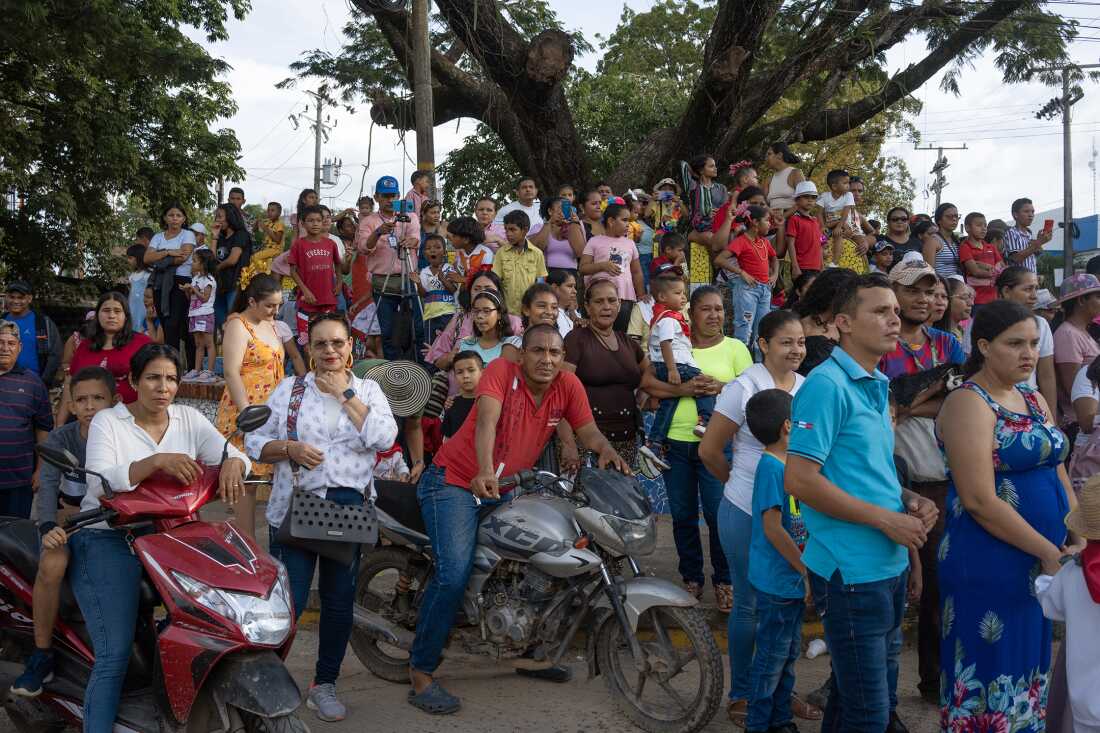
Hundreds of participants, dancers, musicians and cumbia queens parade through the city of El Banco, Magdalena, Colombia, during the Festival Nacional de la Cumbia José Barros Palomino on Oct. 15, 2022.
Karla Gachet
hide caption
toggle caption
Karla Gachet

Yojan David Laguna Ospino and Jakelin Guillen Epalza, both 11, from the dance group Costa Azul Danza Indio Manzos, pose in the community of Playa Blanca in Guamal, near El Banco, Magdalena, Colombia, on Aug. 6, 2022.
Ivan Kashinskhy
hide caption
toggle caption
Ivan Kashinskhy

Melgen Melendez Baena, a cumbia dancer from Barranquilla, holds up his hand as Cristobal Perez Santos, 72, watches the parade of gaitero groups and dancers from his wheel chair as they move through the town and then to the cemetery to pay tribute to the late gaiteros on Aug. 14, 2022, in San Jacinto, Bolivar, Colombia.
Ivan Kashinksy
hide caption
toggle caption
Ivan Kashinksy

The gaita ensemble Son de Quitasol practice on Aug. 13, 2022, during the Festival Nacional Autóctono de Gaitas de San Jacinto. One of the local schools was used by musicians from other places as a place to sleep.
Karla Gachet
hide caption
toggle caption
Karla Gachet
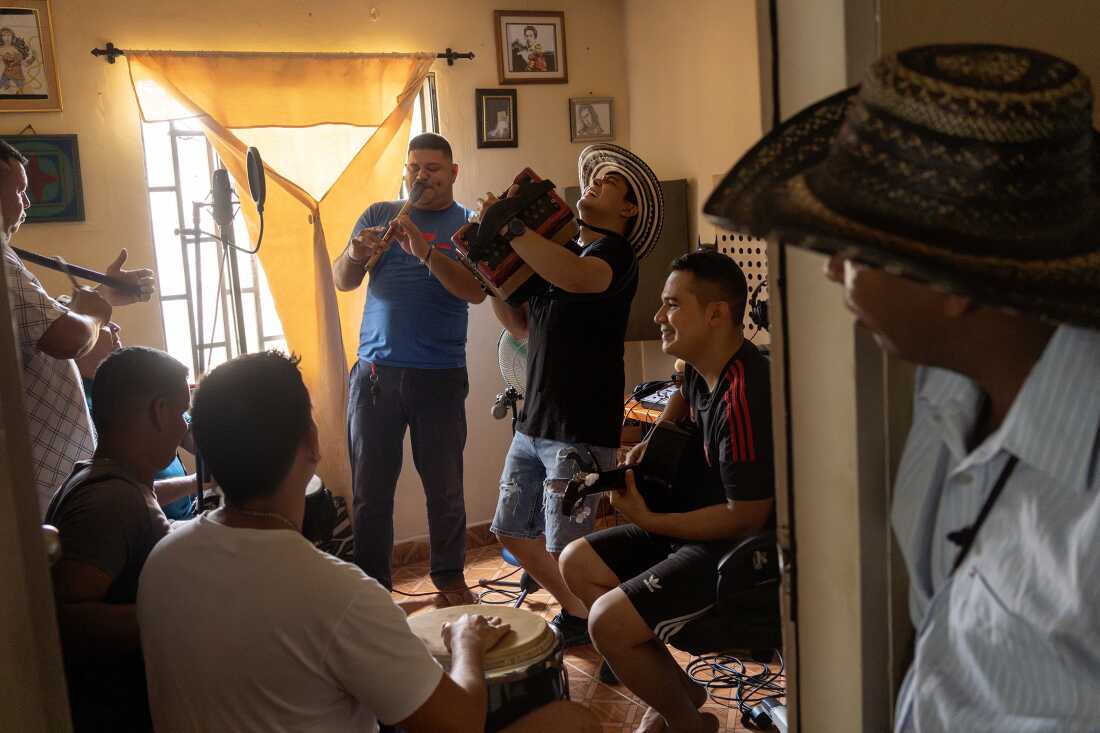
Yeison Landero, grandson of the legendary composer Andrés Landero, records a song at Estudio Mastil Récords on Aug. 12, 2022, in San Jacinto, Bolívar, Colombia, during the Festival Nacional Autóctono de Gaitas.
Ivan Kashinsky
hide caption
toggle caption
Ivan Kashinsky
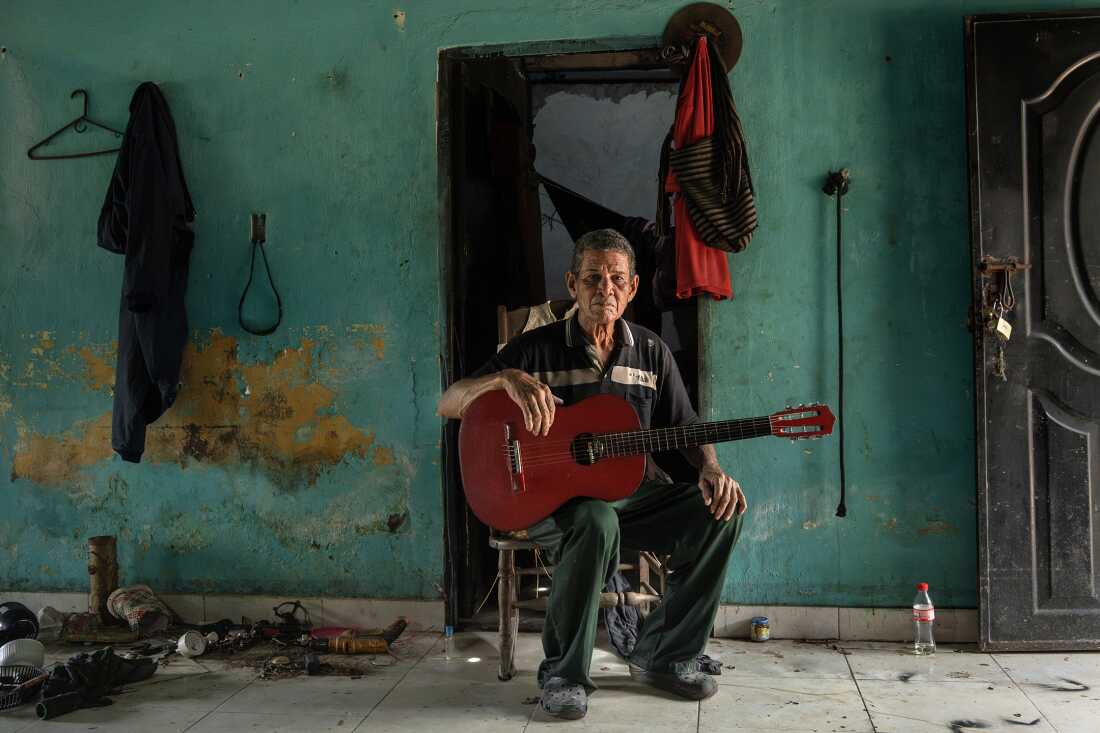
José Benito Africano Mendoza poses for a photo with his guitar in his home in El Banco Magdalena, Colombia, on Aug. 7, 2022.
Ivan Kashinsky
hide caption
toggle caption
Ivan Kashinsky
Emilia Reyes Salgado, known as “la Burgos la Meya,” is one of the best bullerengue singers from San Basilio de Palenque, the first free town in America. Half an hour away, in Arjona, resides Petrona Martinez, the winner of the 2021 Latin Grammy for best folk album, with Ancestras. In María la Baja lives Pabla Flores, who comes from a lineage of singers and has established a school in honor of her mother, who taught her to sing. The African roots of cumbia are expressed not only through its percussion instruments — the tambor alegre, the llamador and the tambora — but also through the voices of ancestors reflected in the sung dances of the region. Black and Afro-descendant women in Colombia are at the heart of these songs, transmitting this legacy from generation to generation.

Ana Regina Ardila Matos poses for a portrait in her hometown of San Martín de Loba, Bolívar, Colombia, on Aug. 5, 2022. Ardila is a cantadora of a rhythm called tambora, which uses the same instruments as cumbia and is closely related. She comes from a tradition of cantadoras — women who compose songs about daily life and pass them down through oral tradition.
Karla Gachet
hide caption
toggle caption
Karla Gachet

Elida Cañates braids extensions on Suleidis Villegas’ hair on Aug. 4, 2022, in Palenque de San Basilio, Colombia. The specific style is called “caminos.”
Karla Gachet
hide caption
toggle caption
Karla Gachet
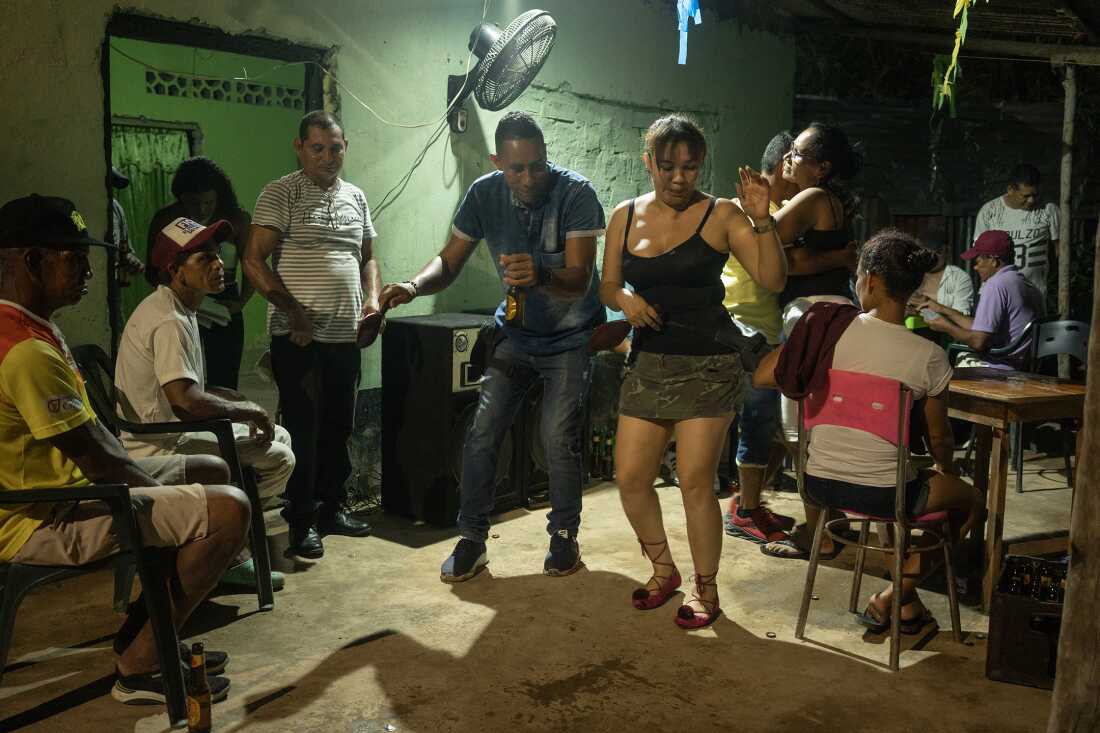

Dawn illuminates the dock and the Magdalena River in El Banco Magdalena, Colombia, on Aug. 9, 2022. The culture of the area, including cumbia, is deeply tied to the river and the fishermen.
Ivan Kashinsky
hide caption
toggle caption
Ivan Kashinsky
San Jacinto, located in the Montes de María, is the epicenter of gaita music, famous for the Gaiteros de San Jacinto and the cumbia of Andrés Landero, one of the most beloved accordionists in Latin America. Historically, this region was also the territory of the FARC (Revolutionary Armed Front of Colombia). It is said that guerrillas would allow musicians to pass if they displayed their instruments. Amid a civil war lasting over half a century, the gaita — a pre-Hispanic flute made from the heart of a cactus and a duck’s feather — became a symbol of peace. These Indigenous sounds breathe life into cumbia.
Jose Benito Barros, originally from El Banco, Magdalena, wrote “La Piragua” and “El Pescador,” iconic Colombian cumbias. Early in his career, Barros did not perform the traditional rhythms of his region. This music, rooted in the experiences of fishermen and people who recite lyrics on the banks of the Magdalena River, was not initially accepted by the middle and upper classes of that time. However, upon realizing the popularity of these rhythms, Barros shifted his musical direction. In 1970, he held the first cumbia festival in El Banco, serving both as a judge and participant. His daughters, along with local elites, continue to host this festival every year. While the main port is decorated to impress the invited authorities, just a few blocks away, the most marginalized neighborhoods continue to face extortion from small armed groups.

Ingrid Cifuentes dances with candles as people play gaitas and drums and dance cumbia in the main plaza on Aug. 13, 2022, in San Jacinto, Bolivar, Colombia, during the Festival Nacional Auntóctono de Gaitas. Gaita is a traditional instrument made from a cactus and is tied to the origins of cumbia.
Ivan Kashinksy
hide caption
toggle caption
Ivan Kashinksy
This coverage was made with the support of the National Geographic Society Explorer program.
Karla Gachet and Ivan Kashinsky are photojournalists based in Los Angeles. You can see more of Karla’s work on her website, KarlaGachet.com, or on Instagram, at @kchete77. Ivan’s work is available on his website, IvanKphoto.com, or on Instagram, at @ivankphoto.
